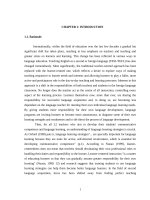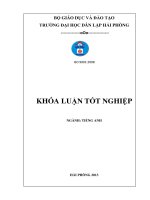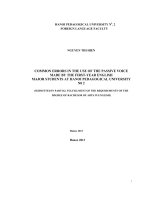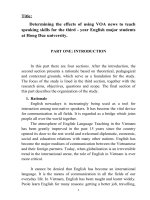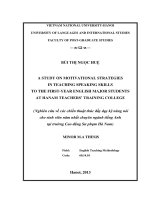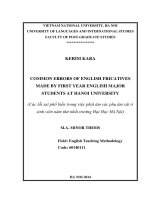Developing autonomy for first year english major students at a university in vinh through writing portfolio
Bạn đang xem bản rút gọn của tài liệu. Xem và tải ngay bản đầy đủ của tài liệu tại đây (1.4 MB, 97 trang )
VIETNAM NATIONAL UNIVERSITY, HANOI
UNIVERSITY OF LANGUAGES AND INTERNATIONAL STUDIES
FACULTY OF POST-GRADUATE STUDIES
---oOo---
ĐOÀN THỊ NGỌC MAI
DEVELOPING AUTONOMY FOR FIRST-YEAR
ENGLISH MAJOR STUDENTS AT A UNIVERSITY IN VINH
THROUGH WRITING PORTFOLIO
(Phát triển tính tự học của sinh viên năm thứ nhất chuyên ngành tiếng anh tại
một trường đại học ở Vinh thông qua hoạt động viết Portfolio)
M.A MINOR THESIS
Field: English Teaching Methodology
Code: 8140231.01
Hanoi - 2019
VIETNAM NATIONAL UNIVERSITY, HANOI
UNIVERSITY OF LANGUAGES AND INTERNATIONAL STUDIES
FACULTY OF POST-GRADUATE STUDIES
---oOo---
ĐOÀN THỊ NGỌC MAI
DEVELOPING AUTONOMY FOR FIRST-YEAR
ENGLISH MAJOR STUDENTS AT A UNIVERSITY IN VINH
THROUGH WRITING PORTFOLIO
(Phát triển tính tự học của sinh viên năm thứ nhất chuyên ngành tiếng anh tại
một trường đại học ở Vinh thông qua hoạt động viết Portfolio)
M.A MINOR THESIS
Field: English Teaching Methodology
Code: 8140231.01
Supervisor: Dr. Nguyen Thi Huong
Hanoi - 2019
DECLARATION
Title: ―DEVELOPING AUTONOMY FOR FIRST-YEAR ENGLISH MAJOR
STUDENTS AT A UNIVERSITY IN VINH THROUGH WRITING PORTFOLIO‖
I certify that no part of the thesis has been copied or reproduced by me from any other
works without acknowledgement and that the thesis is originally written by me under
strict guidance of my supervisor.
Hanoi, 2019
Student’s signature
Đoàn Thị Ngọc Mai
i
ACKNOWLEDGEMENTS
To begin with, I would like to send my profound gratitude to my supervisor, Dr.
Nguyen Thi Huong for her detailed and precise guidance and tremendous support.
Secondly, I would also like to thank my beloved students for their participation
in my action research. Without their enthusiasm, the research could not be completed.
Additionally, I want to send my sincere thanks to the university steering
committee and my colleagues. They are such a great help to me during the process of
research implementation. They not only give me useful advice but also encourage me
to complete the research.
Finally, I must express my very profound gratitude to my husband and my
family for their wholehearted support.
ii
ABSTRACT
Developing and fostering students’ learning autonomy is placed importance for
college students since learning autonomy not only helps them to be more independent
and effective in their studying but also partly lay some bricks on the path of life-long
learning for students. This research is implemented with the purpose of investigating
the use of portfolio writing to enhance the first-year students’ learning autonomy in
writing in particular and in their studying in general. The research is undertaken as an
action research which employs the qualitative method including surveys, interviews
and teaching journals.
The outcome of the research indicates that most of the students find the use of
portfolio writing useful for their learning autonomy. A majority of them has learnt how
to stick on the requirements of the assignments during their writing and be more
responsible for their study. Furthermore, they have become more critical on the
knowledge and information they encountered and started to understand their strengths
and weaknesses to find out their own suitable learning style. However, they are still
struggling with some essential skills such as time management skills. Therefore, most
of them want a better schedule for the writing course. Even though students favor and
find the use of portfolio writing effective, there is a call for further studies to have a
bigger and more detailed picture of the usefulness of portfolio writing before it is
implemented officially in colleges.
iii
TABLE OF CONTENTS
DECLARATION .............................................................................................................i
ACKNOWLEDGEMENTS ...........................................................................................ii
ABSTRACT .................................................................................................................. iii
TABLE OF CONTENTS ..............................................................................................iv
LIST OF FIGURES ......................................................................................................vi
LIST OF TABLES ........................................................................................................vi
CHAPTER 1: INTRODUCTION ................................................................................. 1
1.1. Rationale of the study................................................................................................................................. 1
1.2. Aims of the study ......................................................................................................................................... 2
1.3. Scope of the study....................................................................................Error! Bookmark not defined.
1.4. Significance of the study ............................................................................................................................ 2
1.5. Methods of the study .................................................................................................................................. 2
1.6. Structure of the thesis
........................................................................................................................... 3
CHAPTER 2: LITERATURE REVIEW ..................................................................... 4
2.1. Learner autonomy ...................................................................................................................................... 4
2.1.1. Definitions of learner autonomy .....................................................................................................4
2.1.2. The importance of learner autonomy in language learning .............................................................7
2.1.3. Components of learner autonomy ...................................................................................................7
2.1.4. Some ways to enhance learner autonomy ....................................................................................11
2.2. Portfolio writing ....................................................................................................................................... 12
2.2.1. Definition of portfolio and portfolio writing .................................................................................12
2.2.2. The role of portfolio writing .........................................................................................................13
2.3. Related studies .......................................................................................................................................... 14
CHAPTER 3: METHODOLOGY .............................................................................. 16
3.1. Research method ...................................................................................................................................... 16
3.2. Research design ........................................................................................................................................ 17
3.3. Settings and participants ....................................................................................................................... 23
3.4. Data collection instruments ................................................................................................................... 24
iv
3.4.1. Questionnaire
............................................................................. Error! Bookmark not defined.
3.4.2. Interviews
............................................................................. Error! Bookmark not defined.
3.5. Data analysis.............................................................................................................................................. 26
CHAPTER 4: RESULTS AND DISCUSSIONS ....................................................... 28
4.1. Effects of portfolio writing on the students’ learning management............................................. 28
4.2. Effects of portfolio writing on the students’ learning strategies ................................................... 37
4.3. Effects of portfolio writing on the students’ learning content ....................................................... 45
CHAPTER 5: CONCLUSIONS ................................................................................. 47
5.1. Major findings of the study.................................................................................................................... 47
5.2. Reflection.................................................................................................................................................... 48
5.3. Pedagogical suggestions .......................................................................................................................... 49
5.4. Suggestions for further studies ............................................................................................................. 50
5.5. Limitations of the study .......................................................................................................................... 50
REFERENCES ............................................................................................................. 52
APPENDICES ................................................................................................................ I
I. SYLLABUS ........................................................................................................................................................................ I
II. CHECKLIST FOR SELF-ASSESSMENT, PEER REVIEW AND REFLECTION ...............................IX
III. QUESTIONNAIRE .....................................................................................................................................................XI
IV. INTERVIEWS ...........................................................................................................................................................XVI
III. TEACHING JOURNAL AND STUDENTS’ WRITING EXTRACTS............................................... XXXI
v
LIST OF FIGURES
Figure 1: The classification of cognitive strategies from Oxford (1990:39) ................... 9
LIST OF TABLES
Table 1: The topic of each week in the writing course .................................................. 18
Table 2: Students’ opinions on the effect of portfolio writing on planning and
organizing their learning. ............................................................................................... 29
Table 3: Students’ opinions on the effect of portfolio writing on evaluating their
learning ........................................................................................................................... 33
Table 4: Students’ opinions on the effect of portfolio writing on their cognitive
strategies. ........................................................................................................................ 37
Table 5: Students’ opinions on the effect of portfolio writing on their metacognitive
strategies. ........................................................................................................................ 42
Table 6: Students’ opinions on the effect of portfolio writing on their learning content.
........................................................................................................................................ 45
vi
CHAPTER 1: INTRODUCTION
This chapter presents a general overview on the rationale, aims and objectives,
research questions, significance of the study. In addition, the chosen research methods
and the structure of the study are also provided.
1.1. Rationale of the study
In the past few decades, learners’ autonomy has become a highly – concerned
issue that generated heated debates in the educational forums. In a context where the
necessity of learning and knowledge has been widely acknowledged and lifelong
learning is a global imperative, it is understandable why the importance of learners’
autonomy is gaining even more significance. According to Benson and Voller (1997:
56), ―learning is more effective when learners are active in the learning process,
assuming responsibility for their learning and participating in the decisions which
affect it‖. Furthermore, autonomous learning becomes increasingly necessary to
university students as Malcolm and Rindfleisch (2003:2) pointed out in their study
―students arrive at university with the potential to be autonomous in their learning‖.
Enhancing students’ autonomous learning is also a matter of concern to not only the
researcher in particular but also a university in Vinh in general since from my
researcher’s observation, in the traditional teaching context of Vietnam, Vietnamese
students tend to be passive in their learning. Realizing that writing a portfolio can be
one of the most effective ways to help students enhance their autonomous learning
urged and inspired the researcher to implement the action research ―Developing
autonomy for first- year English major students at a university in Vinh through
Portfolio Writing Activity‖. For the purpose of research ethics, the university would be
named ―X‖.
1
1.2. Aims of the study
The main aim of the study is investigating the extent to which portfolio writing
implementation helps students raise their learning autonomy not only in writing but
also in their learning.
1.3. Scope of the study
The study focuses on three dimensions of learner autonomy, including learning
management, learning strategies and content. The study was carried out as an action
research in an undergraduate writing class at a university in Vietnam where the
researcher was the teacher.
The objective of the paper can be summarized into a research question as below:
To what extent does the use of portfolio writing enhance the first-year
students’ learning autonomy at Foreign Language Department, in University X?
1.4. Significance of the study
As one of the pioneering studies on developing learners’ autonomy via portfolio
writing in that university, the paper would benefit related populations including
English teachers and policymakers there. This study would provide useful information
for policymakers and teachers to consider applying portfolio writing in the curriculum
for the first-year students.
Furthermore, the study would be a reliable reference to other researchers who
share the same interest in developing learners’ autonomy. Further research would be
carried out after limitations of this study are considered.
1.5. Methods of the study
The paper is an action research which employs both qualitative and quantitative
methods. Specifically, the first-year class which the researcher is teaching currently
would join the implementation of portfolio writing which would be integrated as home2
assigned task in the current curriculum of the class. Each week, the students would
write a reflection about portfolio implementation and their learning autonomy. The
students’ reflections would be collected at the end of the semester. A survey and
interviews would be made to collect the students’ opinions toward the influence of
portfolio writing on their learning autonomy.
1.6. Structure of the thesis
The study includes five chapters as follows:
Chapter 1 sketches the overall picture of the whole study. The rationale, aims and
objectives, significance and methods of the research are presented.
Chapter 2 serves as the theoretical frame for the study. Key terms such as portfolio and
learners’ autonomy would be explained. Furthermore, the critical reviews of the related
studies are conducted.
Chapter 3 provides the methodology to carry out the paper. Specifically, the research
method, the participants and instruments, data collection procedure are put forward.
Chapter 4 consists of findings and discussion of the paper which provides the detailed
outcome of the data analysis procedure.
Chapter 5 provides the summary of the research outcome, the pedagogical suggestions,
the limitation of the study.
3
CHAPTER 2: LITERATURE REVIEW
This chapter provides background for the study. Key terms such as “learning
autonomy”, “portfolio writing” and so on are adequately explained. Also, the research
gives the brief review of related studies.
2.1. Learner autonomy
2.1.1. Definitions of learner autonomy
The concept of autonomy has been mentioned a lot over the past few years and has
become a heated topic for discussion recently in Vietnam. Many theorists and scholars
define autonomy in many different ways, which makes the results in this field quite
immense. This study, however, only reviews the literature concerning autonomy in
studying English as the second language.
One of the earliest advocates of autonomy in language teaching, Holec (1981:7),
defines autonomy as ―the ability to take charge of one’s own learning‖. According to
this author, autonomous learners understand the purpose of their learning, share in the
setting of learning goals, take initiatives in planning and executing learning activities,
and regularly review their learning and evaluate its effectiveness. From this point of
view, autonomy is understood to involve activities and attitudes that students possess,
and then develop to various degrees, among which are learning strategies. There is also
a broad agreement among many other scholars to Holec’s ideas. Nunan (1997:193) and
Benson (2001:56) share the same idea that autonomy implies a capacity to exercise
over one’s own learning.
Dickinson (1987) states that autonomy is a ―situation in which the learner is
totally responsible for all of the decisions concerned with his or her learning and
implementation of those decisions.‖ From this perspective, being an autonomous
4
learner requires responsibility for planning and organizing his/her learning and being
able to evaluate his/her learning process and adapting modification if needed. Also, the
role of language teacher would change from a teacher to an information provider,
counselor or assessor. According to Richards and Schmidt (2010:297), this term is
defined as ―the principle that learners should be encouraged to assume a maximum
amount of responsibility for what they learn and how they learn it.‖
According to Freire (1997: 23), autonomy enables learners to get faculty and
freedom to choose the more fitting skills and knowledge taught to him or her.
Nonetheless, Freire also mentions that teachers’ role should not be taken for granted
since they not only provide knowledge but also give chances to learners to build their
own knowledge.
According to Leni Dam (1990, cited in Gathercole, 1990:16) a learner can only
be defined as an autonomous learner when they independently set goals and aims,
select materials, organize useful tasks and be able to evaluate one's their own progress.
Boud (1988:16) states that when leaners become autonomous, they will have an
active role in their own development. They can collect ideas and participate in various
learning opportunities.
Nunan(1997:193)
states
that
―the
fully
autonomous
learner operates
independently of classroom, teacher, or textbooks.‖ In contrast, Palfreyman (2003: 28)
asserts, ―learner autonomy does not mean avoiding any reliance on sources of help
around you‖ but ―means being aware of these sources and what they have to offer in
different situations.‖ For example, if students rely on their teachers for explaining of
new words, it is teacher dependence. However, if a student asks his/ her teacher to
validate his/her own distinction of several synonyms after he/ she already looks up the
dictionary and other sources of reference, it is a sign of learner autonomy. In this case,
the student has drawn his/ her teacher into his/ her own learning agenda, effectively
using the teacher as a source of help.
5
Notably, autonomy also can be though as a social process and a learning process
regarding knowledge construction and power redistribution as well as participants’
roles. A numerous synonyms of autonomy from this viewpoint are given by scholars
such as ―independence‖ (Sheerin, 1991:6), ―language awareness‖ (Lier, 1996:38),
―self-direction‖ (Candy, 1991:54), and ―andragogy‖ (Knowles, 1980:68).
Furthermore, there have been a considerable number of debates between
linguists and educationalists over what autonomy is. According to Little (1991: 17),
learning autonomy is ―essentially a matter of the learner’s psychological relation to the
process and content of learning…a capacity for detachment, critical reflection,
decision-making, and independent action‖. This viewpoint is also favored by Holec
(1981:7) since he also sees that autonomy come regarding learners’ willingness and
ability to control their own learning.
Furthermore, Boud (1988), Kohonen (1992) and Knowles (1975) share the same
opinion that an autonomous learner will be active in the learning process and creating
learning opportunities for themselves. They will not act only upon the stimuli of their
teachers. According to McDevitt (1997:27), ―the end product of education is an
independent learner‖. He also emphasizes that the ultimate goal of education is that
learners’ independence should be cultivated. Littlewood (1996), Nunan (1997) and
Breen (1984) state that learners should acquire autonomy to some extent to become
effective language users.
In short, the study adopts the definition of autonomy set forth by Holec (1981:7)
in which autonomy is viewed as ―the ability to take charge of one’s own learning‖. The
characteristics of autonomous learners include: understanding the purpose of their
learning, sharing in the setting of learning goals, taking initiatives in planning and
executing learning activities, and regularly reviewing their learning and evaluating its
effectiveness.
6
2.1.2. The importance of learner autonomy in language learning
According to Scharle and Szabo (2000:4), ―success in learning very much
depends on learners having a responsible attitude‖. Responsibility for self-learning and
development is considered as the key for studying well. Even though teachers try to
provide knowledge and are willing to help students to gain essential skills, students
will not learn if they themselves do not want to learn. Furthermore, in the language
learning context, lessons in schools are not enough to equip students to communicate
effectively in all daily life and work situation. Therefore, students must be autonomous
in their study and self-taught in their lives.
2.1.3. Components of learner autonomy
According to Benson (2011:56), learner autonomy composes of three
dimensions, namely controlling over learning management, learning strategies and
learning content. Specifically, learning management is observable behaviors involved
in planning, organization and evaluation of learning. Learning strategies comprises of
cognitive and metacognitive processes. Learning content is the what and why of
language learning. The dimensions are considered interdependent.
2.1.3.1. Controlling over learning management
This dimension of learner autonomy refers to the cognitive and attitudinal
factors involved in the process of planning, organization and assessing. Students are
oriented to involve directly in the planning of strategies and sources to assist them to
get their goals. Also, students should assure that they will meet the deadline of
schedule. Afterall, they are required to self-assess their processes to withdraw
experience. At the planning stage, also known as pre-planning (Wenden, 1998:27),
learners identify their objectives and determine how they will achieve them. Planning,
however, may also go on while a task is being performed. This is called planning-in7
action. Here, learners may change their objectives and reconsider the ways in which
they will go about achieving them. At the monitoring stage, language learners act as
participant observers or overseers of their language learning and asking themselves,
"How am I doing? Am I having difficulties with this task?", and so on. Finally, when
learners evaluate, they do so in terms of the outcome of their attempt to use a certain
strategy. According to Wenden (1998:28), evaluating involves three steps: 1) learners
examine the outcome of their attempts to learn; 2) they access the criteria they will use
to judge it; and 3) they apply it.
2.1.3.2. Controlling over learning strategies
2.1.3.2.1. Cognitive Strategies
According to O'Malley and Chamot (1990:44), cognitive strategies 'operate
directly on incoming information, manipulating it in ways that enhance learning'.
Learners may use any or all of the following cognitive strategies (Cook, 1993:114115):
●
repetition, when imitating others' speech;
●
resourcing, i.e., having recourse to dictionaries and other materials;
●
translation, that is, using their mother tongue as a basis for understanding and/or
producing the target language;
●
note-taking;
●
deduction, i.e., conscious application of L2 rules;
●
contextualization, when embedding a word or phrase in a meaningful sequence;
●
transfer, that is, using knowledge acquired in the L1 to remember and
understand facts and sequences in the L2;
●
inferencing when matching an unfamiliar word against available information (a
new word etc.);
●
question for clarification, when asking the teacher to explain, etc.
8
Moreover, as defined by Oxford (1990:39), cognitive strategies can be
diagramed as below:
Figure 1: The classification of cognitive strategies from Oxford (1990:39)
Both the definitions share some same features of cognitive strategies. However, this
study adopts the second definition given by Oxford as the compass for the study
because it offers more detailed features. To make the definition more fit into the study,
some subcategories of cognitive related to writing would be removed. For example,
―formally practicing with sounds‖ does not suit the scope of the study because this
research does not focus on students’ speaking skills. Furthermore, some advanced
9
skills such as ―taking note‖ or ―highlighting‖ would not be focused much since those
skills are way above the students’ levels.
2.1.3.2.2. Metacognitive Strategies
According to Wenden (1998:34), ―metacognitive knowledge includes all facts
learners acquire about their own cognitive processes as they are applied and used to
gain knowledge and acquire skills in varied situations‖. Metacognitive strategies are
skills used for planning, monitoring, and evaluating the learning activity; ―they are
strategies about learning rather than learning strategies themselves‖ (Cook, 1993: 114).
Here are some of these strategies:
●
directed attention, when deciding in advance to concentrate on general aspects of a
task;
●
selective attention, paying attention to specific aspects of a task;
●
self-monitoring, i.e., checking one's performance as one speaks;
●
self-evaluation, i.e., appraising one's performance in relation to one's own
standards;
●
self - reinforcement, rewarding oneself for success.
The definition given by Cook would be adopted in this study.
2.1.3.3. Controlling over learning content
The last dimension of learner autonomy is controlling over learning content, which
refers to the ―what‖ and ―why‖ of learning. According to Benson (2001:99), controlling
over the language content has strong social and political accent. He states that:
Control over the content requires, more than any other aspect of autonomy that
teachers and education authorities create situational contexts in which freedom of
learning is encouraged and rewarded. It also requires that learners develop their
capacity to participate in social in social interactions concerning their learning, to
negotiate for the right to self-determine its broad direction and ultimately to
participate in the transformation of educational structures.
10
Control over the content requires, more than any other aspect of autonomy that
teachers and education authorities create situational contexts in which freedom of
students to choose learning content would be set. Specifically, it refers to who decides
what to learn and how to learn. However, in the school setting, the person who makes a
decision on what to learn is the school policy makers and teachers. Students have little
right on ―control over methodological aspect of learning‖ (Ikonen, 2013). So, Benson
(2011) states that in this dimension, autonomy is reduced to choosing a methodology
for the particular goals and contents. This is called reactive autonomy according to
Littlewood (quoted in Benson, 2001:99):
This kind which does not create its own directions but, once a direction has
been initiated, enables learners to organize their resources autonomously in order to
reach their goal. It is the kind of autonomy that causes learners to learn vocabulary
without being pushed, to take the initiative to do past examination papers or to
organize study groups to complete an assignment.
Notably, many authors only accept the outcome which is called proactive
autonomy by Littlewood (quoted in Benson, 2001:99). This type of autonomy
determines objectives, selects methods and evaluates what has been learned. Also, it
sets directions. Nevertheless, Benson (2001:100) states that reactive autonomy is a step
―toward proactive autonomy‖ or ―as a goal on its own‖.
2.1.4. Some ways to enhance learner autonomy
According to Dickinson (1992: 2), teachers should equip their learners with
appropriate knowledge and tools in order to reach autonomy. In other words, teachers
should help the learners to expose to chances to be independent in their learnings.
Some methods are listed as follows:
Encouraging independence in learning by the teacher displaying full approval
and encouragement towards learners becoming more responsible of their
learning
11
Providing learners opportunities to practice independent learning
Helping learners to perceive the language as a system
Helping learners to develop their learning strategies so that they can practice
their independence.
Teachers can share knowledge they already possess about the language in order
to make students more aware of what to anticipate from language learning.
Therefore, it can be inferred that in order to successfully encourage learners to
become more independent in their learning, teachers should redefine their role within
language education (Hill, 1994:214). However, on the other hand, it may be difficult
for teachers to be able to achieve mainly because they themselves lack the knowledge
of making the transition of being the purveyor of knowledge to a manager of learning
resources (Sheerin, 1997, cited in Benson & Voller, 1997:63).
2.2. Portfolio writing
2.2.1. Definition of portfolio and portfolio writing
Learning portfolio is a compile of students’ work or products in a critically
reflective process. The concept of the student portfolio has been widely known and
implemented for some time in academic fields such as writing, communications, and
the fine arts. Another popular application has been to provide a device for
demonstrating the value of experiential learning or assessing credit for prior learning.
Some portfolios are shared by students and faculty advisors for the purpose of
academic and career advising. Furthermore, portfolio can be used in business and
teacher education to supply a mechanism to present the skills achieved.
O’Malley and Pierce (1996: 34) stated the basic elements of a portfolio despite
the fact that they support the argument that there is hardly a definition of portfolio for
every context. According to them, the essential elements of a portfolio comprise of
samples of learner work, leaner self-assessment and evaluation criteria. The sample
12
could be a variety of work such as writing, audio, video, experiments and so on.
However, all the collections should be organized systematically and goal-oriented.
Furthermore, the process of portfolio making should include evaluating of leaners’
progress. More importantly, it is emphasized that leaners should understand thoroughly
the assessment criteria. Also, it is noted that leaners can also be engaged in discussing
criteria and in goal setting.
In this paper, the scope of the study is only portfolio used for the writing course
for the first-year students. The writing portfolio would be a collection of the students’
topic-based compositions which each includes two versions. The second version is the
modified one of the first one after the students got peers’ comments on the first one.
2.2.2. The role of portfolio writing
Most commonly, students’ writing portfolios have been used to collect and
evaluate students’ work at key points in their progress, usually at the end of an
academic endeavor. Campbell, Melenyzer, Nettles, and Wyman (2000:14)—writing
about portfolios with ―a focus on product‖ for the purpose of certification in teacher
education—make the strong point that in a well-managed portfolio students should
realize that their effort is not simply to construct ―a scrapbook of college course
assignments and memorabilia‖ (p. 2). Instead, a learning portfolio in general and a
writing portfolio in particular should stress that the product is also a process, an
―organized documentation of growth and achievement that provides tangible evidence
of the attainment of professional knowledge, skills, and dispositions. Each portfolio is
goal-driven, original, and reflective‖ (p. 13). Portfolio writing enables students to have
a critical thinking about their learning and making sense of their learning as the whole
process. This leads students to explore and understand what, how and why they should
learn.
13
2.3. Related studies
Numerous studies have been carried out to find out the effects of portfolio on
learning autonomy in teaching and learning languages. In their experimental research,
Khodadady and Khodabakhshzade (2012: 518) evaluated the effect of portfolio and
self- assessment on writing ability and autonomy. According to them, portfolio
assessment and self-assessment improve not only the students’ writing ability but also
autonomy in writing. Moreover, they found that the regular implementation of the selfassessment checklist in and out class influences the students positively. Specifically, it
helps to raise the students’ ―sense of independency‖. Also, Suwaed (2018) investigated
the perception of EFL second-year students of using portfolio assessments in the
writing classroom. His research pointed out that the students have a positive attitude to
the portfolio writing as it helps them to ―improve writing skills‖, ―have a sense of
achievement‖ and ―foster learning autonomy‖. Besides, he mentioned some difficulties
the students had during the portfolio writing. Most of the second year students in that
studies faced work overloading as well as vocabulary and content insufficiency during
writing portfolio. Notably, in his research, he found out that the students ―prefer
portfolio assessment rather pen-and-paper tests.
Furthermore, Khoosf & Khoosravani (2014:36) investigated the use of email
portfolio to enhance EFL learner’s autonomy. The outcome of their research proves
that electronic portfolio largely encourages the students to participate more in the
evaluation process. Electronic portfolios also help to ―connect learning, assessment and
instruction in a new way‖. Thanks to electronic portfolios, students are able to be
aware of the whole picture of their learning which includes ―learning strategies‖,
―learning process‖ and ―self-directed learning‖.
In Vietnam’s ESL context, there have been some pioneering studies
investigating into the use of portfolios to promote learners’ autonomy. For example, in
14
their studies, Duong and Seepho (2017) tried to construct a portfolio-based model for
developing learner autonomy for EFL learners. However, this model uses a general
portfolio, not a writing portfolio specifically. Furthermore, Phung and Dang (2016)
explored the use of e-portfolio on leaner autonomy but in terms of speaking class.
Therefore, there have been a lack of investigating of exploiting a writing portfolio for
promoting learner autonomy in Vietnam. It is hoped that this action research would be
one of the first studies to explore the use of writing portfolio for helping higher
education students to achieve leaner autonomy.
15
CHAPTER 3: METHODOLOGY
This chapter puts forward the description of the methods used in the paper to examine
the effects of portfolio writing on the first-year students at Foreign Language
Department.
3.1. Research method
The paper is carried out as an action research. Specifically, portfolio writing is
imposed to the first-year writing curriculum to observe the impact of the portfolio on
students’ learning autonomy. The independent factor is portfolio writing. The
dependent factor is students’ learning autonomy. According to Kemmis and Mctaggert
(1988), action research is the path that offers the best solution in the professional
context since it provides the essential steps to take actions regarding helping students to
become autonomous learners through ―observing, reflecting, planning and applying in
a spiral action of permanent reflection to improve practice‖ (p.23). This helps the
researcher to observe the changes of the students, the benefits of the portfolio to
students. Also, it exposes the real problems both the researcher and students encounter
during the implementation of portfolio writing in the class. In this research, portfolio
writing is applied in the existing writing class taught by the researcher. The class
includes 40 first- year students who major in English. The portfolio is considered as the
home-assigned task in the writing course.
The research uses both quantitative and qualitative methods, including
questionnaire, interview, and teaching journal. During the implementation of portfolio
writing, the researcher noted down the journal after carrying out the portfolio activity.
However, the teaching journal is considered as the reference to compare and contrast
with the results from the questionnaire and interviews. The questionnaire and
interviews were delivered after the completion of the writing course. The Likert-scale
questionnaire which includes 19 questions were given to the students to investigate
their opinions on how portfolio writing helped them to enhance their learner autonomy.
16
The questionnaire (see Appendix III) was designed based on three dimensions of
learner autonomy mentioned in Literature review. The three dimensions are controlling
over the learning management, learning strategies and learning content. The interviews
were coded and categorized to compare and contrast with the data collected from the
questionnaire and the teaching journal.
3.2. Research design
The chosen research approach for this paper was action research. As
aforementioned in the research methodology, action research is the most suitable for
the paper since it provides the essential steps to take actions through ―observing,
reflecting, planning and applying in a spiral action of permanent reflection to improve
practice‖(Kemmis, McTaggart and Retallic, 2004:2). According to MacIsaac
(1995:15), there are four steps in a typical action research: plan, act, observe and
reflect. This paper followed these four steps and took place in the writing class at
University X, Vinh from September to December 2018.
Step 1: Planning (Before the semester)
● Identify a problem: Witnessing the low level of learning autonomy of the
students in university, especially the first-year students, the researcher made a
decision to integrate the portfolio writing as a trial activity in the current writing
program to enhance the students’ learning autonomy. The effects of portfolio
writing would be evaluated to see if it benefits students and help them to
improve their learning autonomy or not.
● Develop a plan of action: Portfolio objectives, requirements, instructions,
checklist and theme-based topic lists are made to implement the portfolio
writing in the class. The general objectives and instructions were succinct so
that the students would easily grasp the whole process of portfolio writing. The
theme-based topics were prepared. Most of the topics are chosen from the
17
